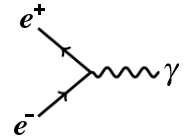 line up the billiard ball with the cue stick. But just as I strike the
ball, somebody sneezes. My cue stick rips the felt and breaks in half. The ball
flies up and hits my opponent in the forehead, knocking him unconscious. He falls
back, smashing through a window, and lands on a lady's poodle. The
headline:
line up the billiard ball with the cue stick. But just as I strike the
ball, somebody sneezes. My cue stick rips the felt and breaks in half. The ball
flies up and hits my opponent in the forehead, knocking him unconscious. He falls
back, smashing through a window, and lands on a lady's poodle. The
headline:
BLOGGER SLAUGHTERS PUPPY IN GRUESOME POOL HALL MASSACRE.
But the true culprit is the chain of causation.
At first glance causation seems obvious: one thing causes something else. But when we examine it closely, we realize that we actually don't understand much about it at all. Many philosophers have struggled with the problem of finding a reductive way of analyzing causation, which means finding a definition that doesn't have a synonym for ‘cause’ in it.
The philosophy of causation goes all the way back to Aristotle's four causes. But the empiricist Hume was the first to look at it analytically. His thinking had a profound effect on how philosophers, such as D.K. Lewis[1], think about causation. Bertrand Russell and the positivists claimed that science had evolved beyond the need for cause and effect. He called it an outmoded concept that was replaced by modern differential equations. In today's terms we would say Russell rejected the concept of a mechanistic or clockwork universe.

In logic, saying “C causes E” is equivalent to the counterfactual statement “E would not have happened if it were not for C.” But philosophers are not happy with counterfactuals: how can a non-event be the cause of something? It opens a Pandora's box: the universe is stuffed to the gills with things that didn't happen. We could construct Rube Goldberg non-chains of non-events: invisible purple giraffes do not exist; therefore through a complex chain of non-events the sun doesn't explode. We all agree on the facts, but the mechanism is dubious.
Thus the eliminativist point of view, by doing away with all this, has a certain appeal. But using counterfactuals to demonstrate causality is the bread and butter of science. A control experiment is a counterfactual: if the sample doesn't undergo the procedure, it shouldn't show the effect. So are placebo controlled clinical trials: if everything that happens to the patient is exactly the same except for the active ingredient, the patient shouldn't get cured.
Every time we run an experiment we are making an assumption that the universe works through cause and effect. Our metaphysical model says the universe works through understandable laws and mechanisms. But even though our theories may be conjectural, experimental results are irrefutable (given certain well known caveats—honesty, reproducibility, accurate measurements, etc.). When those caveats are met, and the result makes sense, scientists say such-and-such a result has been ‘demonstrated.’
But getting to that stage is not so easy. For example, a disease may progress over time, or we might not want to deprive the placebo group of the chance to be cured. So sometimes clinical trials are done using a crossover design: half the patients get the drug for a period of time while the remainder get a placebo, then the groups are switched so the only difference between them is when they got the drug. We then look for differences in the time course of the effect. When more than one thing is changing at one time, the number of controls or test groups increases exponentially and the experimental designs can get very complex. But they are all counterfactuals intended to show causation.
Suppose we are studying whether a protein is causing some effect which is related to learning in the brain. The protein is a kinase, which means it takes a phosphate from a molecule called ATP and attaches it group to the effector protein, like this:
K + E + ATP → EP
(K = kinase, E = effector protein, P = phosphate). Biology today is strongly interventionist: we use antisense RNA to knock out K, doing a test tube counterfactual, to see if we get less EP. We overexpress K to see if we get more. We test the components in isolation to see if they interact physically and chemically. We express the results in pathway diagrams, also known as directed acyclic graphs, some of which are enormously complex, like this one. Pity the poor biochem student who has to memorize them.
But even here, getting the experimental manipulation ‘surgical’ enough can be a challenge. In the old days we used inhibitors to block K, but inhibitors are rarely 100% specific. There are also many other kinases K1, K2, K3, ... which could be alternatives or obligatory intermediates in the pathway. Or K could be downstream of K1, K2, or K3. Or K could be inhibiting a phosphatase, which changes EP back into E. And so on. The list of possibilities seems endless. What starts out as a simple experiment to show a simple cause-and-effect relationship can turn into a lifetime project.

An electron and positron interacting. Their mass is converted to energy, which is carried off by a gamma ray. In Feynman diagrams, the 'time' arrow is reversed for antiparticles.
To a physicist, causation is the same as energy. The electrical field around a charged particle that causes one billiard ball to push another is a form of energy. So you might say that whenever energy is invoked, we are invoking causality.
In many cases, such as protein-ligand interactions or in particle physics, it's more convenient to use the word ‘interaction’ instead of ‘causation.’ Some suggest that's because causation is an anthropomorphism that we tend not to apply to molecules. For subatomic particles, there's also the fact that phenomena can arise from interactions with other particles or they can be random and spontaneous, i.e. ‘uncaused.’
But even more challenging is the phenomenon of nonlocality, where two quantumly entangled particles can be separated by many kilometers yet still behave as a single particle. If the state of one of the particles is measured, the entanglement ‘decoheres’ and its partner instantly changes into the opposite state, apparently violating the fact that information cannot travel faster than the speed of light.
Physicists have found that non-determinism and nonlocality are related: non-determinism can be deduced from nonlocality, suggesting that it is nonlocality, not randomness, that is the basic axiom of quantum mechanics.[2]
Some physicists are now exploring the idea that nonlocality is not as paradoxical as it seems: space itself might be nonlocal. The most parsimonious explanation might just be that adjacent points in space need not always be close to each other on a subatomic level. If space itself is a tangle of entangled tangles, then entanglement of an entangled particle merely adds another tangled tangle to the tangle.

Space might have stuff like this in it
Let me try that sentence again. Nonlocal points might be, unbeknownst to us, in close proximity, connected not by wormholes as we imagine them in the movies, but by some strange property of spacetime. Stated another way: to the entangled pair, the two particles might not actually be far apart at all. We are learning that space is a lot more complicated than it looks.
Einstein was famously uncomfortable with nonlocality as well as with the idea of uncaused events. And he was right to be: causation is such a useful concept we shouldn't give it up so easily. Maybe ‘random’ is best considered as a placeholder to be filled in by some mechanism to be discovered in due course, just as we use ‘dark matter’ as a placeholder for whatever is happening out there. Just as dark matter could well turn out not to be matter and not dark, random events could someday turn out to be caused by something.
Philosopher Huw Price once asked why the causal arrow seems to be aligned with the arrow of time: why, he asked, do causes always seem to precede effects despite the fact that the laws of physics are, for the most part, time-agnostic? His conclusion was remarkable: the time asymmetry of cause and effect, he said, is a product of an asymmetric viewpoint on a symmetric state of affairs: “It is our perspective as deliberators that underpins the distinction between cause and effect.”[3] [emphasis in the original]
In other words, just as walking down the street in a certain direction defines which side is left and which is right, the way we waltz through the space-time continuum determines which is the cause and which is the effect. It's not just that the principle of cause and effect is convenient because we want to make things happen. Somehow it might be related to the fact that we are sentient beings.
Philosophy tells us which things are false, and science tells us which things are true. They make a good team.
last updated apr 03 2016 2:56 pm
1. Lewis, D. (1973) Counterfactuals, Cambridge, MA: Harvard University Press. Reissued London: Blackwell, 2001.
2. Aharonov, Y. and Rohrlich, D. Quantum Paradoxes: Quantum Theory for the Perplexed (Wiley-VCH, 2005); Shimony, A. in Proc. Int. Symp. Foundations of Quantum Mechanics (eds Kamefuchi, S. et al.) 225–230 (Physical Society of Japan, 1983).
3. Price H and Weslake B (2009) The time-asymmetry of causation. In The Oxford Handbook of Causation. Beebee, Hitchcock, and Menzies, eds. Oxford University Press, 2012.

